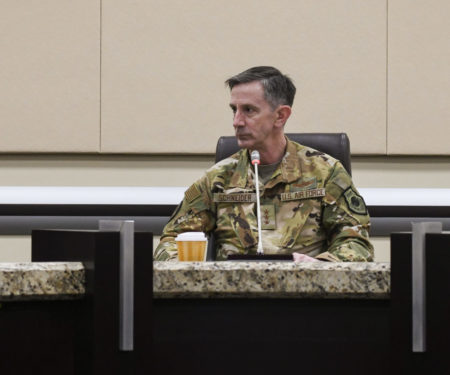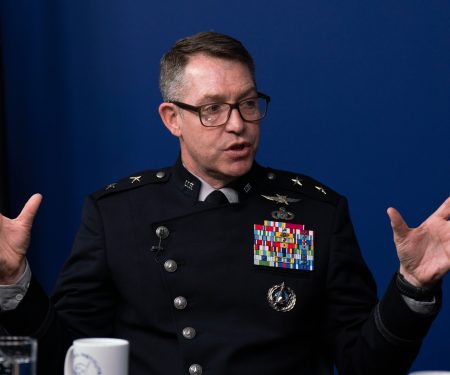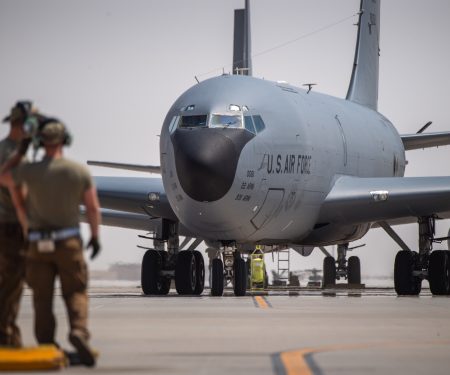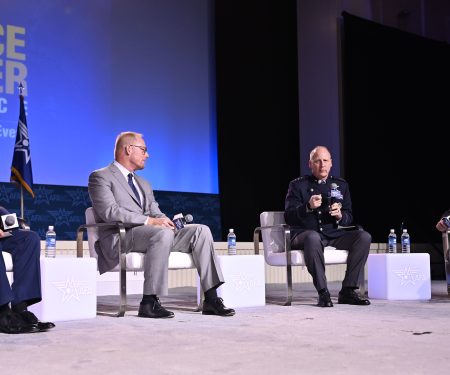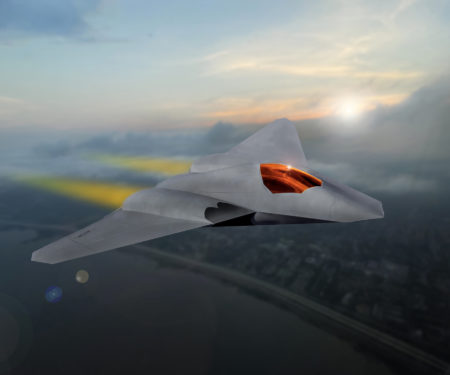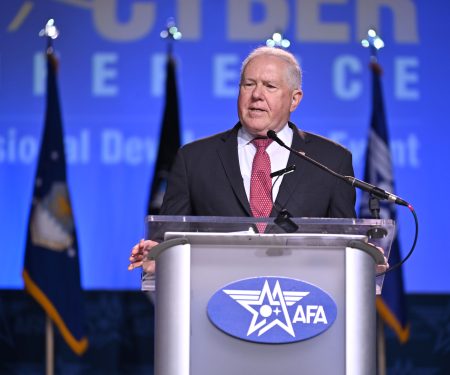USSF Intel Boss: China Now Has 1,000 Satellites on Orbit
Air Force Could Scrap KC-135 Replacement If It Can Speed Up Next-Gen Tanker
Air Force Ups Recruiting Goals for 2025 After Hitting 2024 Targets
‘We’re Struggling’: Leaders Say Air and Space Forces Need More Resources for Pivotal Stretch
Kendall: New, Re-Imagined NGAD Could Cost Less Than an F-35
Allvin Announces Standup of Provisional Integrated Capabilities Command
Kendall Wants to Stay as Air Force Secretary Under New President
Expert: Air Force, Other Services Need to Embrace Cyber as Weapon of War
Radar Sweep
How the Air Force Averted a Major Flaw in Its Drone Wingmen Approach
Whatever the next chapter of U.S. air power will look like, there will be drones—and lots of them—accompanying manned fighters into battle. But as Air Force leaders translated their vision into an acquisition strategy, a novel meeting of the minds—at least by Defense Department standards—may have saved the service from a major miscalculation: A new cohort of so-called collaborative combat aircraft, as originally envisioned, wouldn’t be able to fly far enough to be effective in combat, which would have been a serious problem in the Pacific theater.
Putin Orders Russian Army to Become Second Largest After China’s at 1.5 Million Strong
President Vladimir Putin on Sept. 16 ordered the regular size of the Russian army to be increased by 180,000 troops to 1.5 million active servicemen in a move that would make it the second largest in the world after China’s. In a decree published on the Kremlin’s website, Putin ordered the overall size of the armed forces to be increased to 2.38 million people, of which he said 1.5 million should be active servicemen.
16th Air Force Looking to Reevaluate How It Generates Requirements with Phoenix Initiative
The Air Force’s information warfare organization is looking to change how it develops requirements for new capabilities and concepts. Created in 2019, 16th Air Force consolidated several commands and capabilities for intelligence, surveillance, reconnaissance, cyber, electronic warfare, information operations and weather, to set up an integrated information warfare command.
OPINION: The Army Doth Protest Too Much: In Space, Jointness Must Come First
“Our Aug. 13 op-ed on the Army’s overreach to create a new space career field and expand its space control capabilities struck a surprising chord and generated a robust and frankly overdue debate about the Army’s role in space. After reading the Army’s formal rebuttal, visiting soldiers doing space missions, and having many conversations with members of the U.S. Space Command, our takeaway is clear,” write Charles Galbreath and Jennifer Reeves of the Mitchell Institute for Aerospace Studies.
Keeping the Air Force Powered Up
Driven by the growing reach and threat of adversaries, the Air Force is paying more and more attention to ensuring its bases are energy resilient and can generate combat power in any contingency. Learn more about how bases around the U.S. and the world are making sure their energy grids are more reliable and can take a punch if need be.
Everything We Just Learned About the Supersized AGM-158 XR Stealth Cruise Missile
Lockheed Martin has provided new details about their AGM-158 Extreme Range (XR) variant of the proven Joint Air-to-Surface Standoff Missile (JASSM) family of munitions. JASSM now underpins much of the USAF’s deep strike capabilities and a growing portion of the Navy and Air Force’s air-launched anti-ship capabilities via its sister, the Long-Range Anti-Ship Missile (LRASM). We have known the XR version of this weapon has been in development for some time, but this is the first time we have seen it and have gotten official details about its configuration.
Space Development Agency Eyes Laser Link Between Different Contractors’ Birds
As of this weekend, York Space Systems has gotten the laser communications system working on their recently launched satellites for the Space Force’s nascent Low Earth Orbit network, the director of the Space Development Agency said Sept. 16. The next step, Derek Tournear told reporters, is to get York’s satellites linked by laser to SpaceX’s birds.
Space Force Awards $45 Million to Universities for Propulsion and Power Research
The U.S. Space Force awarded nearly $45 million to the Rochester Institute of Technology and the University of Michigan to spearhead advanced research in space power and propulsion. These universities will lead the third Space Strategic Technology Institute, part of the Space Force’s University Consortium initiative. The program, which is also supported by the Air Force Research Laboratory, aims to foster academic research aligned with the strategic needs of the Space Force.
Cybersecurity a Top Priority for Military Satellites as Threats Loom
U.S. military satellites acquired by the Space Development Agency for its low Earth orbit constellation undergo rigorous cybersecurity evaluations ahead of their deployment, as SDA emphasizes the need to mitigate vulnerabilities before launch.
PODCAST: Shoot to Kill: The Day America Launched an ASAT
In episode 201 of the Aerospace Advantage, members of the Mitchell Institute team chat with retired Maj. Gen. Doug Pearson, the pilot who took “the shot” and directed the F-15 Anti-Satellite Combined Test Force, and retired Col. Jack Anthony, the Operations Officer at Cheyenne Mountain about this incredibly historic mission. At the height of the Cold War, the United States Air Force demonstrated the ability to shoot down a satellite in Low Earth Orbit from an F-15 fighter aircraft. While this did not result in a fielded capability, the lessons related to technology, planning, coordination, and operational execution offer valuable insight into future cross-domain operations.
Air Force Needs to Fix Big Gaps in Early Stages of European Attack Response, Analysts Say
The U.S. Air Force in Europe is not up to the split-second coordination of air and missile defense with allies, leaving Europeans in mortal danger in the event of an attack, according to a new report commissioned by the service.
Northop Grumman Releases New Connect-Everything Communications, Intelligence, Cyber System
Northrop Grumman will release a new “tool box” of connected technologies, physical processors and radar apertures as well as software defined signals intelligence, cyber effects and communications all in one, the company announced at the Air & Space Force Association’s Air, Space & Cyber conference at National Harbor on Sept. 16.
Pentagon to Oversee $3 Billion Effort to Strengthen Microchip Supply
The Pentagon announced today it will help lead a $3 billion U.S. Commerce Department initiative designed to make sure the U.S. military has access to a reliable domestic microelectronics supply chain. The first task order under what’s known as the Secure Enclave program was awarded to leading microchip developer Intel Corp.
AAC Ramps Up Interest in Adding Air Force to Conference with Army and Navy
The American Athletic Conference has ramped up interest in adding Air Force as a member to put all three service academies into the same league for the first time, a person with knowledge of the AAC’s discussions told The Associated Press on Sept. 16.

